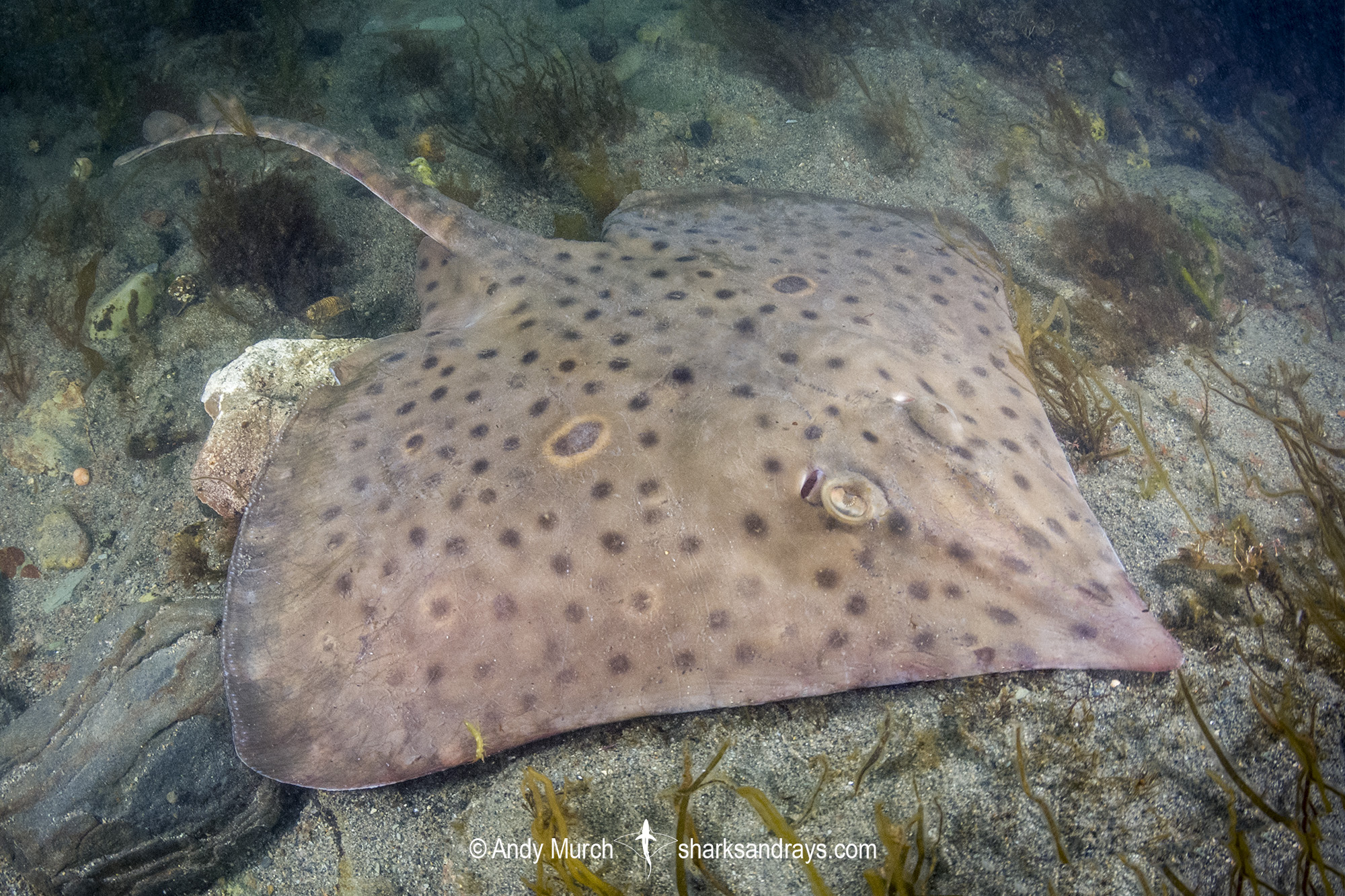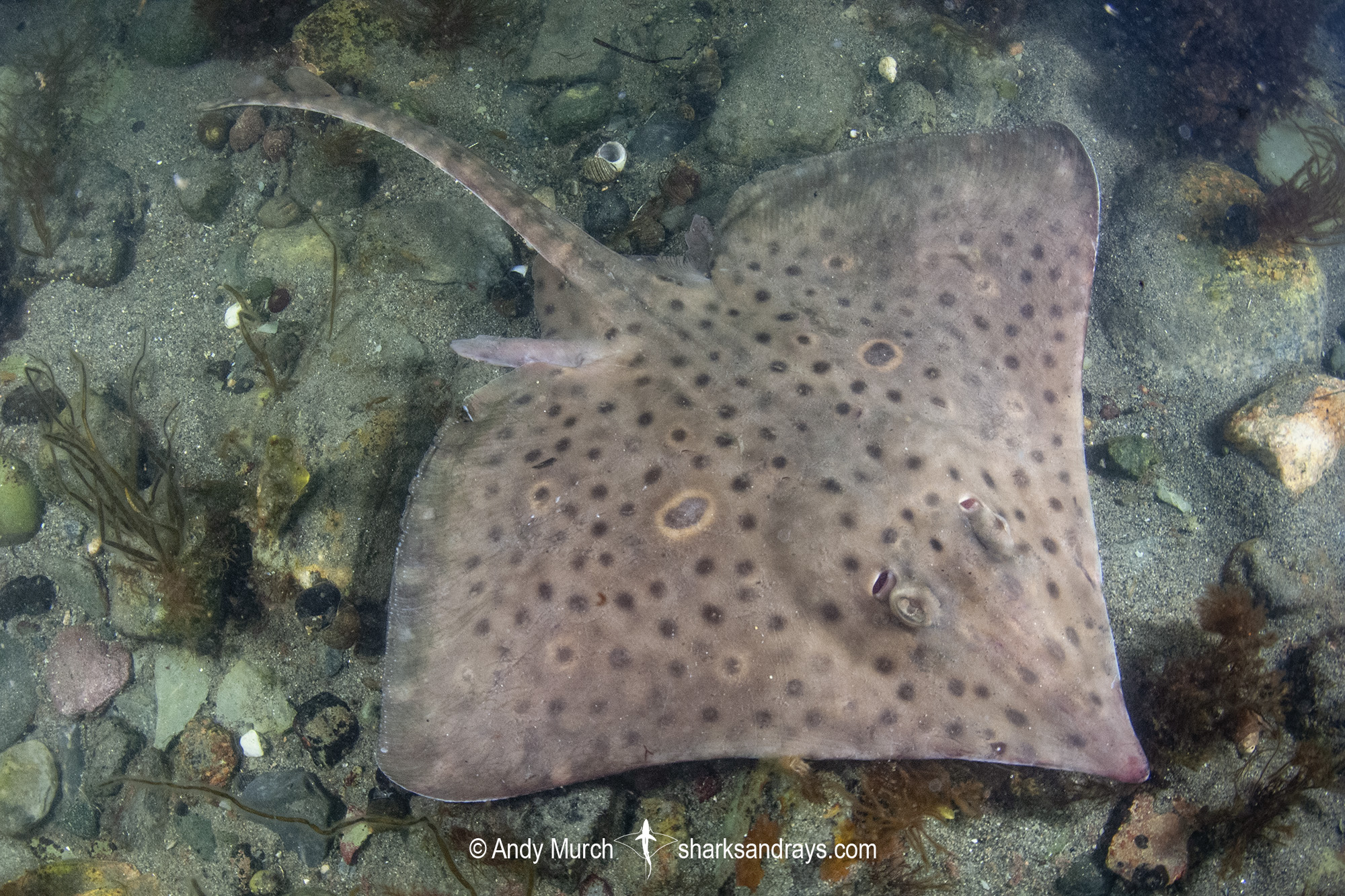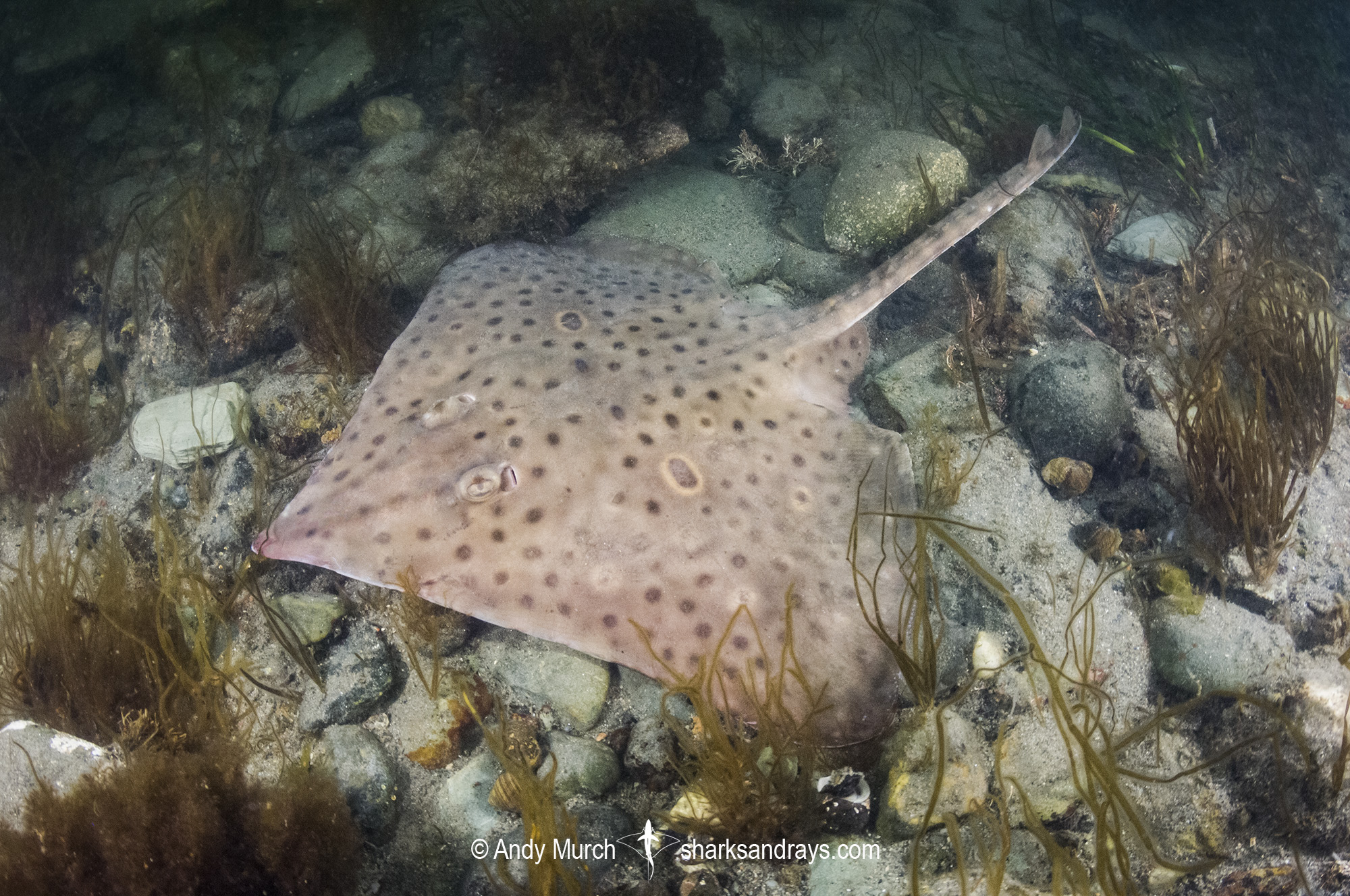Common name(s)
Barndoor Skate.
Identification
A very large skate with a wide kite-shaped disc. Disc width 1.3 x disc length. Snout long with a right-angular or slightly acutely angular tip. Snout length 3.6 x orbit length. Anterior margins of pectoral fins slightly concave. Pectoral apices narrowly rounded. Disc covered in coarse denticles but with very few thorns. Small orbital thorns present in juveniles. Median row of 22-40 thorns from tail base to first dorsal fin. Thorns also present laterally on tail. Tail slender, length sub-equal to pre-cloacal length. Pelvic fins large and deeply notched. Anterior pelvic lobe slightly shorter than posterior lobe. Dorsal fins broadly rounded and slightly separated.
Colour
Dorsum grey-brown to pinkish-brown with numerous, evenly distributed, roughly eye-sized, dark spots sometimes with pale, diffuse outer rings. One, dark, oval ocellus with a pale outer ring, in the centre of each pectoral fin. Ventrum dusky, darker near disc and pelvic margins.
Size
Maximum length 163cm. Length at hatching 18-19cm.
Habitat
Cold temperate seas. Demersal on soft or mixed substrates. From 10-1174m, but mostly found between 50-150m.
Distribution
Northwest Atlantic. Found from Cape Hatteras in North Carolina to Newfoundland and Labrador, Canada. Scattered records of barndoor skates also exist from the Grand Bank and the Flemish Cap (Last et al. 2016).
Conservation Status
LEAST CONCERN
Historically in the northwest Atlantic, skates were taken as incidental catch of groundfish fisheries with high fishing effort, particularly distant water fleets on Georges Bank in the 1960s and 1970s. The extension of the USA and Canadian 200-mile exclusive economic zones in 1977 excluded vessels from other countries. The steep decline in the Barndoor Skate was coincident with the sharp increase in landings in the 1960s and 1970s (Simon et al. 2002, COSEWIC 2010).
In Canada, a targeted skate fishery, mainly for Thorny Skate (Amblyraja radiata) and Winter Skate (Leucoraja ocellata) was initiated on the Grand Banks and Scotian Shelf, in 1994, following the closure of groundfish fisheries (as a result of overfishing of Atlantic Cod Gadus morhua and other species) and a rise in international demand for skate wings (Kulka and Mowbury 1999). Canadian fishermen did not target Barndoor Skate and the species was only taken infrequently as bycatch of demersal trawl fisheries for Atlantic Cod and redfish (Sebastes spp.) and in scallop dredges on the shelf, as well as in deep-water fisheries on the outer edge of the Grand Bank (Cavanagh and Damon-Randall 2009). Fishing effort on demersal fish in Canadian waters has declined substantially in the past two decades as a result of several moratoria (cod, plaice), closed fisheries (grenadier) and reduced quotas (redfish, flounder) (D.W. Kulka unpubl. data 2019). There has been a notable and sustained increase of Barndoor Skate observed in commercial fishery and research survey data on the Scotian Shelf and Georges Bank since the mid-1990s (Cavanagh and Damon-Randall 2009).
In the USA, Barndoor Skate was taken primarily in two fisheries: the targeted skate wing fishery comprising 60% of landings and the lobster bait fishery comprising 40% of total skate landings (of mainly Little Skate, Leucoraja erinacea) (Cavanagh and Damon-Randall 2009). The skate wing fishery was developed in the 1990s in response to overfishing of traditional groundfish species. Skates were primarily the incidental capture of groundfish trawl and gillnet fisheries targeting Atlantic Cod (Gadus morhua), flounders (Pleuronectiformes), monkfish (Lophius spp.), and sea scallops (Placopecten magellanicus). The largest species in the skate complex, including Winter Skate, Thorny Skate, and Barndoor Skate, had their wings removed (‘winged’) for local consumption and international trade, with Winter and Thorny Skate preferred (Curtis and Sosebee 2015). The New England scallop fishery has the second highest discard rates after the groundfish trawl fishery. The post-release survival of Barndoor Skate taken in scallop dredges is estimated to be very low (0.06%) (Knotek et al. 2018). From 2003 to 2018, however, the possession and landing of Thorny and Barndoor Skate was generally prohibited (Cavanagh and Damon-Randall 2009, NOAA Fisheries 2020). An interim experimental fishery with the aim of improving biological information while investigating “premium market” development was approved in 2014 (NOAA Fisheries 2014). Barndoor Skate stock was recently considered rebuilt and beginning in September 2018 a limited harvest is now allowed in US waters. In 2018, New England fishery managers reduced the precautionary buffer used in the determination of allowable skate catches from 25% to 10% despite persistent uncertainty regarding skate fishery data and population (NOAA Fisheries 2018).
Citation
Kulka, D.W., Cotton, C.F., Anderson, B., Herman, K., Pacoureau, N. & Dulvy, N.K. 2020. Dipturus laevis. The IUCN Red List of Threatened Species 2020: e.T39771A124413280. https://dx.doi.org/10.2305/IUCN.UK.2020-3.RLTS.T39771A124413280.en. Downloaded on 22 April 2021.
Reproduction
Oviparous. Approximately 47 egg cases are laid each year. Egg cases are deposited in summer. Hatching occurs after 6 months.
Diet
The barndoor skate feeds on a variety of small bony fishes and invertebrates.
Behavior
Barndoor skates occur at greater depths in the most northerly part of their range.
Reaction to divers
Very docile. Remains motionless relying on camouflage unless molested.
Diving logistics
Although the barndoor skate is occasionally recorded close inshore, most records occur below 50m so this species is rarely encountered by divers.
What’s new
View our full list of updates
Similar species
In the northwestern Atlantic, no other skate species have a similar disc shape with uniformly positioned dark spots.




